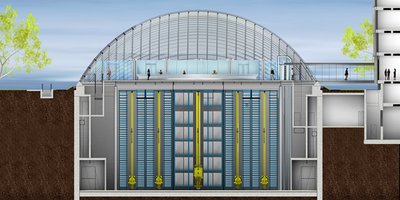Automated Storage and Retrieval System

In high-density automated shelving systems, barcoded items are sorted by size and stored in bins. The technology underlying high-density automated shelving (known as automated storage and retrieval systems, or ASRS) has been used in other industries for many years. Ford and GM store new cars in such systems. Only in recent years has this type of high-density automated storage technology been adapted from large-scale industries for use in the modern research library.
The Joe and Rika Mansueto Library's ASRS shelves materials underground by size rather than library classification, in racks 50 feet high, with a capacity to hold materials in one-seventh of the space of conventional shelves.
This video demonstrates how the system works:
All items selected for the ASRS have their barcodes scanned and are placed in barcoded bins that are stored in the ASRS. Each item is scanned whenever it is removed from and returned to the ASRS, as is the new bin into which the item is deposited. This allows the Library's computerized systems to track the location of all materials stored in the ASRS at all times, and allows Library patrons to request materials from any computer with an Internet connection, via the Library Catalog. Rare and archival materials from the Hanna Holborn Gray Special Collections Research Center are stored in boxes that are barcoded and stored in special racks along with extremely large materials (elephant folios) and retrieved in a similar manner. Upon request, a robotic crane retrieves materials stored in the ASRS almost instantaneously (within minutes of a patron's order).
Smaller ASRS installations are currently in use or planned for only a handful of U.S. research libraries.
The ASRS was constructed in five phases.
- Rack components were delivered in bundles and lowered into the basement while dome was constructed above ground.
- Rack construction began in the outer two aisles in the basement, working from the north end to the south. Once each outer aisle was completed, work moved to the inner aisles, and then finish with the center aisle.
- Crane construction was completed inside the basement, and the cranes were fitted into their racks as completed.
- Empty bins were installed.
- Final commissioning and inspections were conducted.